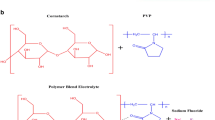Abstract
Gum arabica obtained from acacia plant is a conducting biopolymer. Experiments are carried out on this natural gum arabica. In the present study TGA, ion transference number, transient ionic current, thermal analysis, frequency and temperature variation of a.c. conductivity, Arrhenius plot and volt-ampere characteristics of specimens are carried out. The total electrical conductivity of these biopolymers are comparable to that of synthetic polymers doped with inorganic salts. The ion transference number of these biopolymers show their superionic nature of electrical conduction. The overall conduction mechanism seems to be protonic in nature rather than electronic one.
Similar content being viewed by others
References
Almond D P and West A R 1987Solid State Ionics 23 27
Aspinall G O and Wood T M 1963J. Chem. Soc. (London) 1696
Aspinall G O and Wood T M 1965J. Chem. Soc. (London) 3003
Aspinall G Oet al 1968Carbohydrate Res. 7 244
Barton D and Olis W O (eds) 1979Comprehensive organic chemistry, the synthesis and reaction of organic compound inbiological compounds (Oxford, UK: Pergamon Press) Vol. 5, p. 740
Bermudez V Z, Poinsignon C and Armand M B 1997J. Mater. Chem. 7 1677
Chandra S 1981Superionic solids—Principle and application (Amsterdam: NHPC)
Chowdari B V R (ed.) 1996Solid state ionics, Parts I & II (Amsterdam: NHPC)86-88 pp 297–414
Colomban P and Novak A1992Proton conductors solids, membranes and gels—Materials and devices (ed.) P Colomban (Cambridge: Cambridge Univ. Press) p. 266
Epstien A J 1986Handbook of conducting polymers (ed.) T A Skotheim (New York and Basel: Marcel Dekker Inc.) p. 1065
Epstien A J, Rommelmann H and Gibson H W 1985Phys. Rev. B31 2502
Glasby J S 1982Encyclopaedia of the terpenoids (New York: John Wiley & Sons) p. 971
Glasser L 1975Chem. Rev. 75 21
Howe A T and Shitten M G 1980J. Solid State Chem. 34 149
Hummel R E 1993Electronic properties of material (Berlin: Springer-Verlag) 2nd ed., p. 155
Jonscher A K 1997Nature 267 23
Poulsen F W 1989Solid ionic conductor—Recent trends and application (ed.) T Takahasi (Singapore: World Scientific) p. 166
Sarkar A 1997Solid State Phys. (India) C40 409
Sarkar A 1998Tenth nat. conf. on ferro and dielectrics (Madras: IIT)
Shimura T, Komori M and Iwahara H 1996Solid State Ionics (ed.) B V R Chowdari (Singapore: World Scientific)86-88 p. 685
Soni P L and Srivastava H C 1988Indian J. Chem. B27 1093
Soni P L and Srivastava H C 1992Structural polysaccharide chemistry (Dehra Dun: A Surya Publication) p. 13
Wagner J B and Wagner C J 1957Chem. Rev. 26 1597
Yamashita Y and Nicholson P S 1986Solid State Ionics 20 147
Author information
Authors and Affiliations
Rights and permissions
About this article
Cite this article
Mallick, H., Sarkar, A. An experimental investigation of electrical conductivities in biopolymers. Bull Mater Sci 23, 319–324 (2000). https://doi.org/10.1007/BF02720090
Received:
Revised:
Issue Date:
DOI: https://doi.org/10.1007/BF02720090




